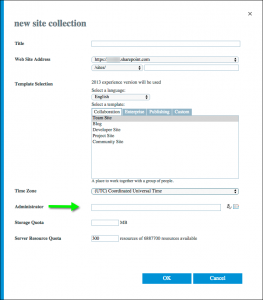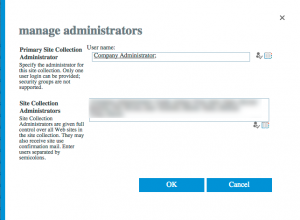Adding SharePoint licenses to Office 365 can be a bit tricky.
If you add the E3 license, you get EVERYTHING that comes with E3, if that’s what you need, great, but what if you ONLY want SharePoint, and not Lync, email, etc??
I ran into this recently and used a few resources to come up with a script.
This article was really helpful: http://www.powershellmagazine.com/2012/04/23/provisioning-and-licensing-office-365-accounts-with-powershell/
As was some script work by an awesome guy I work with named Chris.
The tricky thing here is you can’t directly grant just a SharePoint license in MSOL E3…
You have to do it subtractively.
Let me explain…..
Say you have 3 letters, A, B & C
You might expect to add a license for b like this:
Add-license -option B
It doesn’t work that way. (At least not in 2015 when I wrote this)
Instead you have to say:
Add-License -disable A C
No problem you say.
“I’ll just add code to disable A C”
That’s great, until….
Microsoft adds Option D
Now, when you try
Add-License -disable A C
You’ve just assigned a B and D license, when you only wanted to assign a B license.
Now you see the issue….
The solution is not too hard – we can pull a list of all options available, remove the one we want, and then build the disable list from that.
This way we won’t get caught when Microsoft springs options EFGHI on us.
The full script is below.
Note: there are some unused functions in the script for setting a password – if you have brand new users to Office 365, they may never have used their identity and will need the password reset and sent to them, if that’s the case, just add the call to Reset-Password -upn $upn at the appropriate place(s)
Here’s the script:
#http://sharepointjack.com
#based on content from http://www.powershellmagazine.com/2012/04/23/provisioning-and-licensing-office-365-accounts-with-powershell/
#use at your own risk, while this has worked for me, you should always test in a test environment and understand what it is the script is doing before using it.
write-host "Don't forget to connect to MSOL first!" -foregroundcolor yellow
Start-transcript
function main()
{
#variables used in the program
$script:MissingUsers = @()
$script:SMTPServer = "YOUR.SMTP.ADDRESS.COM"
$importFilename = "_SPOUserList.txt"
$LicenseType = "TENANTNAME:ENTERPRISEPACK"
$SubLicense = "SHAREPOINTENTERPRISE"
$path = $(get-location).path
$userlist = get-content -path "$path\$importfilename"
foreach ($upn in $userlist)
{
$upn = $upn.trim()
#note the continue statement on next line, this skips the rest of the loop if the user is not found.
if ((Check-UserExists -upn $upn) -ne "YES") {write-host "skipping $upn" -foregroundcolor black -backgroundcolor yellow; continue}
if ((CheckUserHasPrimaryLicense -upn $upn -PrimaryLicense $LicenseType) -eq $true)
{
#user has E3 license
Write-host "User $upn has $LicenseType License, adding $SubLicense SubLicense"
Add-SubLicense -upn $upn -PrimaryLicense $LicenseType -SubLicense $SubLicense
} else {
#user has no license of any kind, but is still provisioned in MSOL
write-host "User $upn does not have a license for $LicenseType adding now"
Assign-NewLicense -upn $upn -Location "US" -PrimaryLicense $LicenseType -SubLicense $SubLicense
}
#note, if you need to reset the users password and email that to them, add a line such as:
# Reset-Password -upn $upn
}
Report-MissingUsers #report the names of any missing users so they can be investigated
}#end main
##---------------------------------------------------------------------
## Utility Functions from here down
##---------------------------------------------------------------------
##---------------------------------------------------------------------
## this function checks the upn (email address) to see if they exist at all in MSOL
## typically if they don't, there is a misspelling or other problem with the name and we want to report on that...
##---------------------------------------------------------------------
function Check-UserExists ($upn)
{
$spouser = get-msoluser -user $upn -erroraction silentlycontinue
if ($spouser -eq $null)
{
Write-host "user >$upn< Not found in MSOL" -foregroundcolor DarkRed -backgroundcolor Gray
$Script:Missingusers += $upn
return $false
}
else
{
return $true
}
}
##---------------------------------------------------------------------
## this function checks the upn (email address) to see if it has the passed primary License (For example TENANTNAME:ENTERPRISEPACK)
## it returns true if the user has this license, and false if they do not.
##---------------------------------------------------------------------
function CheckUserHasPrimaryLicense ($upn, $PrimaryLicense)
{
$ReturnValue = $false
$spouser = get-msoluser -user $upn
$count = $($spouser.Licenses | where {$_.AccountSkuId -EQ $PrimaryLicense}).count
write-host "Found exactly $count Licenses that matched $PrimaryLicense for user $upn" -foregroundcolor yellow
if ($count -eq 1)
{ $ReturnValue = $true }
return $ReturnValue
}
##---------------------------------------------------------------------
## this function Adds a given SubLicense (for example SHAREPOINTENTERPRISE)
## to a users Pre-Existing License (for example TENANTNAME:ENTERPRISEPACK)
##---------------------------------------------------------------------
function Add-SubLicense($upn, $PrimaryLicense, $SubLicense)
{
$spouser = get-msoluser -user $upn
#assemble a list of sub-licenses types the user has that are currently disabled, minus the one we're trying to add
$disabledServices = $spouser.Licenses.servicestatus | where {$_.ProvisioningStatus -eq "Disabled"} | select -expand serviceplan | Select ServiceName | where {$_.ServiceName -ne $SubLicense}
#disabled items need to be in an array form, next 2 lines build that...
$disabled = @()
foreach ($item in $disabledServices.servicename) {$disabled += $item}
write-host " Adding Sub-license $SubLicense to existing $PrimaryLicense License to user $upn" -foregroundcolor green
write-host " Disabled License options: '$Disabled'" -foregroundColor green
$LicenseOptions = New-MsolLicenseOptions -AccountSkuId $PrimaryLicense -DisabledPlans $disabled
set-msoluserlicense -userprincipalname $upn -licenseoptions $LicenseOptions
}
##---------------------------------------------------------------------
## this function Assigns a new Primary License ($PrimaryLicense) and SubLicense to a users MSOL account
##---------------------------------------------------------------------
Function Assign-NewLicense($upn, $Location, $PrimaryLicense, $SubLicense)
{
#assemble a list of sub-licenses available in the tenant, we want to disable all but our target sublicense
$disabledServices = get-msolaccountsku | Where {$_.accountSkuID -eq $PrimaryLicense} | Select -expand "ServiceStatus" | select -expand "ServicePlan" | select ServiceName | where {$_.ServiceName -ne $SubLicense}
#disabled items need to be in an array form, next 2 lines build that...
$disabled = @()
foreach ($item in $disabledServices.servicename) {$disabled += $item}
write-host " Adding Completely new $PrimaryLicense license with $SubLicense sublicense for user $upn " -foregroundColor cyan
write-host " Disabled License options: $Disabled" -foregroundColor cyan
$LicenseOptions = New-MsolLicenseOptions -AccountSkuId $PrimaryLicense -DisabledPlans $Disabled
Set-MsolUser -UserPrincipalName $upn –UsageLocation $Location
Set-MsolUserLicense -User $Upn -AddLicenses $PrimaryLicense -LicenseOptions $LicenseOptions
}
##---------------------------------------------------------------------
## This function changes the MSOL users password and
## emails the user the temp password and some basic instructions
##---------------------------------------------------------------------
Function Reset-Password($upn)
{
#generates a random password,
#Changes the MSOL Password,
#emails the user the temp password and some basic instructions
$tempPassword = Generate-Password
Set-msolUserPassword -UserPrincipalName $upn -NewPassword $tempPassword
$to = $upn
$cc = "adminemail@yourdomain.com"
$from = "adminemail@yourdomain.com"
$Subject = "Important: Temporary password for your SharePoint Online Account"
$body = "Hello, <br/><br/> You've just been granted a license for SharePoint Online.<br/><br/>"
$body += "Your user ID is <b>$upn</b> and your Temporary Password is <b>$TempPassword</b><br/>"
$body += "Please log on to <a href='http://portal.office.com'>http://portal.office.com</a> <b>right now</b> and change the temporary password above to one you'll remember.<br/><br/>"
write-host "Sending email"
Send-MailMessage -From $from -to $to -cc $cc -Subject $subject -bodyashtml $body -SmtpServer $script:SMTPServer
Write-host "Email sent to $upn with $tempPassword"
}
##---------------------------------------------------------------------
## This function generates a random password
## 17 chars long with guaranteed min of 1 number, 1 lower and 1 upper case
##---------------------------------------------------------------------
Function generate-Password
{
$alphabetUpper = $NULL;
for ($a=65; $a -le 90; $a++)
{
$alphabetUpper+=,[char][byte]$a
}
$alphabetlower = $NULL;
for ($a=97; $a -le 122; $a++)
{
$alphabetlower+=,[char][byte]$a
}
$ascii=$NULL;
For ($a=48;$a -le 122;$a++)
{
$ascii+=,[char][byte]$a
}
$Fullset=$null
For ($a=48;$a -le 57;$a++) #0-9
{
$Fullset+=,[char][byte]$a
}
For ($a=65;$a -le 90;$a++) #A-Z
{
$Fullset+=,[char][byte]$a
}
For ($a=97;$a -le 122;$a++) #a-z
{
$Fullset+=,[char][byte]$a
}
$onepassword = $null
#start password with an alphabetical letter.
$onepassword += (get-random -InputObject $alphabetlower)
$onepassword += (get-random -InputObject $alphabetUpper)
#now add a number to guarantee we have a number
$onepassword += get-random -Minimum 0 -Maximum 9
#now add 14 random chars from the combined set.
for ($pwlen=0; $pwlen -le 11; $pwlen++)
{
$onepassword += (get-random -inputObject $Fullset)
}
return $onePassword
}
##---------------------------------------------------------------------
## This function displays/emails any missing user infomation
##---------------------------------------------------------------------
function Report-MissingUsers()
{
if ($script:MissingUsers.length -gt 0)
{
write-host " -------------------------------------- "
Write-host " The following users were not found in SPO: " -foregroundcolor magenta -backgroundcolor gray
$script:Missingusers
Write-host " ^^^^^^^^^^^^^^^^^^^^^^^^^^^^^^^^^^^^^^^^^^ " -foregroundcolor magenta -backgroundcolor gray
$to = "adminemail@yourdomain.com"
$from = "adminemail@yourdomain.com"
$Subject = "Missing users in last license assignment"
$body = $script:MissingUsers -join "<br/>"
write-host "Sending email of missing users to $to"
Send-MailMessage -From $from -to $to -Subject $subject -bodyashtml $body -SmtpServer $script:SMTPServer
Write-host "Missing user email sent to $to"
}
}
main #call main procedure, this line must be the very last line in the file.
Stop-transcript #ok, actually this line must be the very last line...


